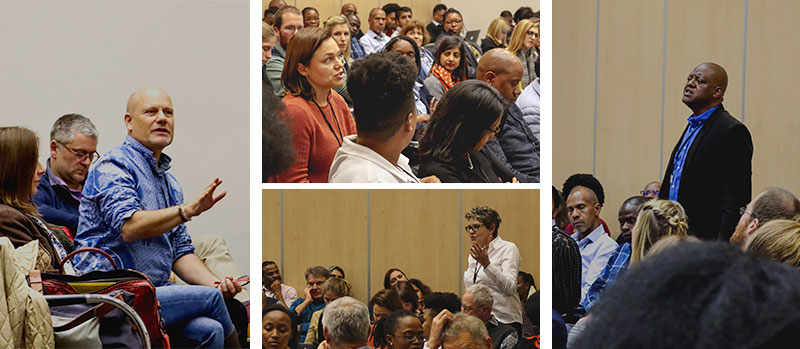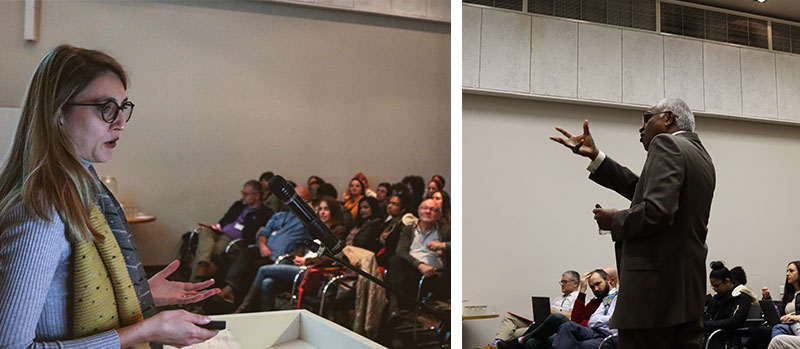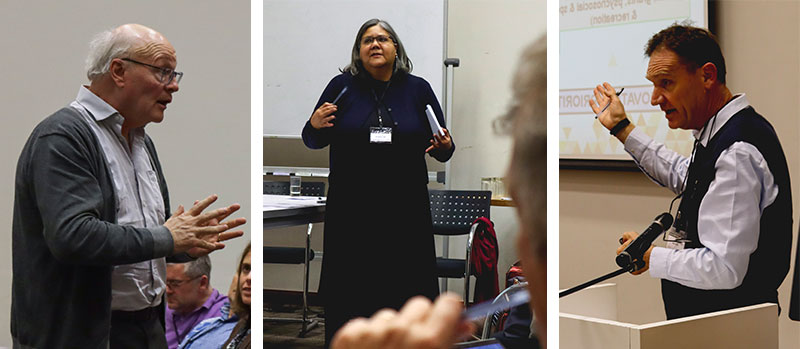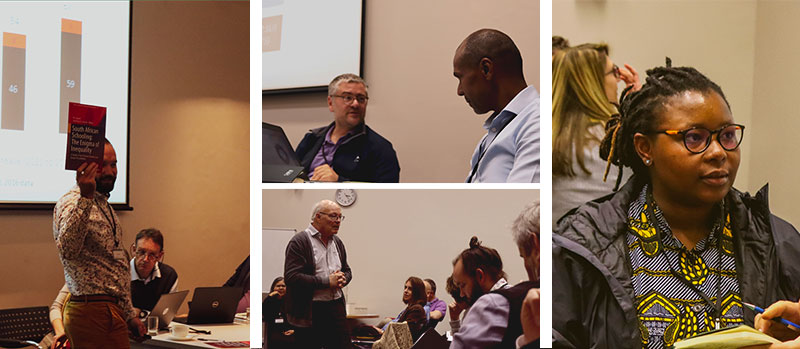Quantitative Education Research Conference again
a huge success
On 12 and 13 September, RESEP held its fifth Quantitative Education Research Conference at the Stias Conference Centre in Stellenbosch. As in past years, it was attended by about 100 researchers, senior policymakers and stakeholders from all over South Africa. Funding was provided by the Zenex Foundation, the Michael and Susan Dell Foundation and RESEP itself. The conference was preceded by a smaller workshop on 11 September for emerging researchers in education.

This year, the main speaker was Prof. Sean Reardon of Stanford University, who spoke about Race, class, and educational opportunity in the United States. Using a unique data set of 330 million tests scores in grades 3 to 8 collected for all 13 000 American education districts over eight years, he showed how educational opportunity still varies widely in the US (this data set and an interactive tool will soon be made available on the internet). Reardon distinguishes between early childhood and elementary school experiences that influence grade 3 test scores (the earliest scores available), and opportunities provided by schools, which largely determine the growth of test scores between grade 3 and grade 8. He concludes that the role of schools differ depending on where you are: In some places they play an equalizing role, in other places they exacerbate inequality, and in some places inequality changes little during school years. More than race or class, he argues, economic segregation is the strongest predictor of how unequally schools provide opportunity.
Presentation available here.
Other presentations are for convenience grouped under three headings: learner and school performance; finance and policy; and language issues.
Learner and School Performance
Chris van Wyk, Servaas van der Berg, Rebecca Selkirk and Kate Rich analysed the learner-level data drawn from SA-SAMS that underlie the dashboards used for the Data Driven Districts initiative of the Michael and Susan Dell Foundation and the New Leaders Foundation. They show that such data can reveal much that conventional EMIS (Annual School Survey) cannot, for instance in terms of patterns of progression, who drops out in grade 10 (especially over-aged children, mainly boys), how current performance in school based assessments predict later performance in both primary and secondary schools, that frequent absence from school is often a predictor of repetition or dropout, and how subject choice between Mathematics and Mathematics Literacy in grade 10 is associated with performance in the mathematics grade 9 performance.
Presentation available here.
Linda Zuze and Andrea Juan investigated the relationship between school leadership and local learning contexts, using TIMSS data in a paper related to their recent publication (Zuze, T. L., & Juan, A. (2018). School leadership and local learning contexts in South Africa. Educational Management Administration & Leadership). They use both descriptive data and multi-level modelling and identify instructional leadership as well as promoting a safe and orderly environment as the most important school leadership and management factors relating to learner performance.
Download their presentation here.
Gabrielle Wills presented research funded by the DG Murray Trust on quantifying repetition and drop-out from schools and its cost. She emphasised that repetition is high, and a source of great waste in the education system, but also pointed out that “The problem of poor-quality schooling – of which repetition is a symptom – is a far greater cost to individuals and the South African economy than considering the issue of repetition in isolation.” She also warned against unforeseen consequences of sudden changes in repetition policy.
Presentation available here.
In her presentation, Debra Shepherd set out a methodology to identify schools performing above expectation and showing promise in Mathematics in a study for Tshikululu to identify poor schools for the ‘Maths Challenge’. The tool developed used a combination of four indicators, namely: above expected performance in Maths when considering socio-economic circumstances (school quintile) and their performance in English First Additional Language; stability in this above-expected performance; a combined Maths and Maths Literacy pass rate of at least 40%; and a potential for improving pass rates and reducing failure rates in Mathematics by more appropriate subject choice between Maths and Maths Literacy.
Presentation available here.
Hamsa Venkat spoke about an intervention to transcend the widely encountered unit-based counting approaches in early Mathematics learning by supporting teachers in a small sample of schools to implement teaching approaches focused on calculating by structuring. Though the intervention increased the ability to use number structures, it is a long and difficult process to change teacher behaviour and their ability to implement such teaching strategies.
Presentation available here.
Drawing from J-PAL’s international experience in developing countries, Ashleigh Morrell emphasised the importance of teaching at the right level. This experience has shown that the syllabus is often too advanced for many of the children in developing country schools, and once they fall behind there is not really much opportunity for catching up. She outlined current projects to pilot ‘teaching at the right level’ in various African countries and some of the challenges involved.
Presentation available here.

Policy and Finance
The second day of the conference started with a presentation by Rufus Poliah of the DBE, who set out the latest policy developments in terms of assessment. Of particular interest here was the issue of the new systemic testing to replace the Annual National Assessments and the introduction of the General Education Certificate (GEC) in grade 9. Systemic tests would be used to evaluate the health of the school system and will be administered in a sample of schools to an intact class in grades 3, 6 and 9 every three years. The tests will have a matrix design (i.e. not all learners will write the same questions), will cover Mathematics and Languages, and will be multiple choice with some common items across the grades. Six questionnaires are being developed, for learners, parents, teachers, principals and districts, plus a customised whole-school evaluation booklet. Each of the approximately 1600 schools sampled school per grade will be visited by three officials to administer the test and the questionnaires. This will mean that the test will be written by almost 200 000 across the three grades.
Presentation available here.
Martin Gustafsson & Tsekere Maponya addressed the question of whether South African teachers really are among the best paid in the world, as UNESCO-OECD data would seem to indicate. They critique the existing methods for making such comparisons across countries and come to the conclusion that these methodologies exaggerate how attractive South African teacher salaries are in comparative perspective.
Presentation available here.
John Kruger and Thabo Mabogoane evaluated South Africa’ national education plans. They set out a planning structure to evaluate the National Development Plan (NDP), its levers and targets before focusing on education plans. They are critical about the many (27) goals in the DBE’s Action Plan 2014-19, but also show that there is already much data to inform monitoring and evaluation in education, perhaps more than in other sectors. But they lament the lack of a shared vision and argue that there is a need to move beyond the strategic level to implementation level and for stronger mechanisms to incorporate research and learning in order to tighten monitoring.
Presentation available here.
Gabrielle Wills chaired a lively panel discussion on finance in education, involving Spencer Janari, John Kruger, Nic Spaull and Michael Sachs. The other panellists took issue with some of Spaull’s estimates and analysis of the real (inflation-adjusted) decline in spending on school education. Sachs in particular argued that the real source of the fiscal squeeze in education lies not in teacher wage negotiations but in wage negotiations affecting the whole public sector. He also emphasised the crowding out of education spending in provinces by rising spending on health, particularly in Gauteng. Janari provided an explanation of the equitable share formula and addressed questions around a potential review of how it currently works.
Language
Nwabisa Makaluza presented fascinating research on deriving a quantitatively determined difficulty index for isiXhosa reading texts. This required electronic capturing of the isiXhosa text corpus and converting that into quantitative information on word length and syllable, phoneme and lemma frequency. She explained the difficulty of doing so for isiXhosa, an agglutinating language, where a sequence of morphemes are attached to a stem. Her presentation made clear not only how important it is to develop language-specific benchmarks for reading, but also that there is a need for language-specific training of teachers on how to teach reading.
Presentation available here
Nompumelelo Mohohlwane investigates language policy and practice as the source of sustained inequality in education. She shows that there is a clear gap in African languages research, particularly focusing on reading and its application to policy and practice. She also discusses the very long route that is required for policy changes through legislation, but then states that an important potential policy change, namely postponing the transition to English as Language of Learning and Teaching (LOLT) beyond grade 4, is already possible within current legislation.
Presentation available here.
Elizabeth Pretorius tracked early reading trajectories in Zulu and Xhosa. She links the learning of reading to neural processes necessary for reading, and identifies different stages in this learning process. She points out that it is easier to develop automaticity in reading when orthographies have visually dissimilar words, as is common amongst English words, whereas in contrast, the complex morphology of agglutinating languages such as Zulu and Xhosa results in many letter sequences with visually similar consonant-vowel (CV) patterns. Pretorius refers to a source that found that there are over 30 visually similar syllable sequences in Zulu. “This requires attention to detail and hence more cognitive work while reading; there is loss of meaning if any of the bits within the linguistic unit are decoded inaccurately.”
Presentation available here.







